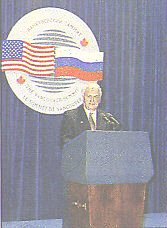TORTURE IN RUSSIA
|
Know Whom you are dealing
with. You
may wish to decide whether you feel comfortable about our credibility,
before you read our opinions and advice |
Document Courtesy of Palms & Company
TORTURE IN RUSSIA
|
Know Whom you are dealing
with. You
may wish to decide whether you feel comfortable about our credibility,
before you read our opinions and advice |
![]() About The Portal To
Russia -----
About The Portal To
Russia ----- ![]() How To Subscribe -----
How To Subscribe -----
 Электронная
почта Dr. Palms
Электронная
почта Dr. Palms
Amnesty International submitted a report in April 1997 detailing
its concerns about widespread use of torture in Russia of suspects. The
torture methods used in pre-trial detention by the police include asphyxiation,
known in Russian as Slonik (elephant'). A gas-mask is placed on the suspect
and the supply of oxygen is restricted or cut off repeatedly until the
suspect suffocates. Tear gas is sometimes introduced until the suspect
vomits inside the mask. Beatings, and special methods of physical restraint,
known as lastochka ("swallow") are employed. The suspect is handcuffed
behind the back, above the level of the head, whereby the victim's back
is arched painfully and he is hung from the ceiling. A full copy of the
report is available at:
Amnesty
International ![]()
Torture has included adolescents 13-17 years old. Deaths in custody from beatings on the chest while handcuffed has been registered as heart failure.
The report of the Russian Presidential Commission on Human Rights noted that in 1994 more than 20,000 Interior Ministry employees were disciplined for breaking the law while conducting investigations and interrogations. This figure did not indicate how m. violations involved torture.
Current legislation facilitates torture. "I am all for the violation of human rights if the human is a bandit or a criminal" Sergey Stepashin in 1994, then head of the FSB commenting on the Presidential Decree on fighting organized crime No 1226.
Moscow Mayor Yury Luzhkov: "Now we have to take actions. We have to take all of them out of Moscow. Everyone. The whole Diaspora" Police Office: "Well if you only allow us - I will certainly introduce terror on the streets." Mayor Luzhkov: "Yes, The Whole Chechen disapora - out of here. Police office" It's about time we did that, Yury Mikhaylovich, You are right - it's about time" Mayor Yury Luzhkov: "We have warned them many times."
The conditions in many prisons, particularly for those awaiting trial, remain appalling and amount to cruel, inhuman or degrading treatment. Some prisoners have waited years for their cases to come to court. Speaking of two such prisons in Moscow, the U.N. Special Rapporteur on Torture, said: "the senses of smell, touch, taste and sight are repulsively assailed. His "Recommendations for immediate action" that: "the government of the Russian Federation .remove from confinement on remand (isolators) all 71,000 detained in excess of the officially proclaimed capacity of existing institutions"
Lung, circulatory and skin diseases especially tuberculosis and scabies are widespread. In the pre-trial detention center SIZO in August 1995 140 prisoners were crammed into a 630 sq. ft. cell designed to hold 35 inmates. In July 1995 11 prisoners dies of heat-stroke in Novokuznetsk, when the air temperature rose to 120 degrees fahrenheit. There are hundreds of cases involving people detained for stealing $2 items. Such people spend an average of 10 months in pre-trial detention.
A 16 year old boy was sentenced to two and a half years imprisonment for stealing three hamsters from a pet shop.
Statistics are very closely held on the number of detainees and prisoners who were killed or died. According to Russian human rights groups between 10,000 and 20,000 detainees and prison inmates died, some due to beatings, but most as a result of overcrowding, inferior sanitary conditions, or lack of medical care. Confessions by prisoners extracted under torture are used as evidence, sometimes leading to the death penalty.
Many observers believe that the Russian army today is a prison-like Gulag-style institution where the treatment of soldiers is not much different from the treatment of penal institution prisoners and in many cases much worse. In 1994 423 soldiers committed suicide and 2500 died as a result of "criminal incidents". The mothers' Rights Foundation estimated the total at 5,000.
Although Russia undertook to impose a moratorium on executions upon becoming a member of the Council of Europe in February 1996, 140 prisoners were executed in 1996. 700 more are under sentence of death. Yeltsin turned down 46 petitions for clemency in February and April 1996 In May 1996 President Yeltsin refused to grant clemency to 22 prisoners. There is strong evidence to suggest that among those executed were people who are innocent of the crimes of which they were convicted.
Russia's Second Periodic Report to the United Nations Committee against Torture states in point 23: "The criminal law of the Russian Federation contains no regulation directly providing for making the performance of torture illegal or subject to penalty".
Go to TOP of this page
 RETURN to Palms' Lobby
RETURN to Palms' Lobby
 RETURN TO HOME PAGE
RETURN TO HOME PAGE
CAN YOU REALLY RELY UPON PALMS & COMPANY?
You are One of the ![]() Who can.
(World Population Counter)
Who can.
(World Population Counter)

|
|
No, we don't
need Palms. |
Attention Brokers, Agents , Intermediaries, Mandates of Principals/Buyers
Go to TOP of this page
 RETURN
TO HOME PAGE
RETURN
TO HOME PAGE